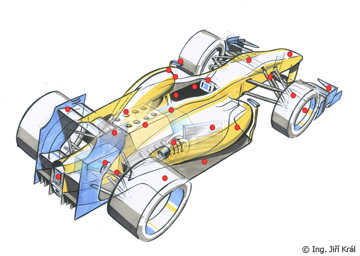The Brembo brakes on every single-seater tackle almost 1,000 braking sections at the Monaco GP
Alessandra Fedeli/ Brembo | 28.5.17 | Brembo F1 brzdy
Brembo F1 2017
The Brembo brakes on every single-seater tackle almost 1,000 braking sections at the Monaco GP
Nearly one fourth of the time is spent braking and more than 211 kWh are dissipated in braking during the GP: Monaco reaffirms itself as the track where drivers brake the most.
From May 25 to 28, the Circuit de Monaco will host the 6th race of the 2017 World Formula 1 Championship. The track that winds through the streets of the principality of Monaco has hosted the most advanced single-seaters in the world without interruption since 1955, although the first Formula 1 GP was held here in 1950.
The proximity of the Armco barriers mandates that drivers perform with utmost precision: braking incorrectly, even by just one yard, could result in crashing into the guardrail and withdrawing from the race. For this reason, the braking systems have to work well all the way to the checkered flag. It isn't an easy task because each car is required to brake about 940 times during the GP.
Monaco is one of those tracks that stands out for a high aerodynamic load and a significant percentage of time spent braking, but these braking sections are not particularly intense. In spite of braking sections that are on average only slightly intense, this track is nonetheless demanding on the brakes, especially because of the high temperatures reached by the calipers and brake fluid.
In the past, the temperatures of the calipers and brake fluid reached exceptionally high levels, in some cases causing vapor lock when the liquid inside the caliper boils over. This led to increased pedal travel, which caused the brakes to respond more slowly.
Now, the work done by Brembo technicians to cool the brakes has alleviated those problems and the increase in the number of ventilation holes as of this year, going from 1,200 to 1,400, should offer extra security.
According to Brembo technicians, who classified the 20 tracks in the World Championship on a scale of 1 to 10, the Circuit de Monaco falls into the category of circuits presenting medium difficulty for the brakes. The track near the border with Italy earned a 7 on the difficulty index, which is the same score given to the Barcelona, Sepang and Hungaroring tracks.
The demand on the brakes during the GP
Monaco is the shortest track in the World Championship, measuring only 3,337 meters, and yet it has the most braking sections per lap: there are 12, five more than Montreal, which is considered one of the most demanding tracks for the braking systems.
The effort required of the brakes is not directly correlated to the number of braking sections, nor to the time spent braking. On the Monaco circuit, the drivers use their brakes for 16 seconds every lap, which totals 23% of the overall duration of the race and is the record for the World Championship.
Since the stretches are not very fast, with the partial exception as the cars exit the tunnel and the Mirabeau, the braking never exceeds 1.9 seconds. And there are four corners where the peak deceleration doesn't even reach 3 G. That translates into an average deceleration of 3.6 G, which is exactly one point lower than that registered at Sochi.
The numerous braking sections means the amount of energy each car dissipates in braking over the entire course of the GP is really high: 211 kWh.
From the starting line to the checkered flag, the Brembo technicians forecast that each driver will apply a load of 116 tons on the brake pedal, which is the same as the total weight of 92 Ferrari LaFerrari cars. In other words, the drivers will be required to apply a force of more than 1,050 kg on the brake pedal every minute of the race.
The most demanding braking sections
Of the 12 braking sections at the Circuit de Monaco, only one is classified as demanding on the brakes, seven are of medium difficulty and four are light.
The most difficult braking section is after the tunnel (turn 10): the single-seaters arrive going 286 km/h and brake for less than 2 seconds (1.98 seconds to be precise) to decelerate to 89 km/h. They manage to do so in just 56 meters, which is barely more than half of the length of the Stade Louis II soccer field. At this point, the drivers undergo a deceleration of 4.7 G and have to apply a load of 155 kg on the brake lever.
At Mirabeau (turn 5) on the other hand, the speed drops down from 234 km/h to 79 km/h, but the single-seaters brake for 2.04 seconds and travel 45 meters. The load on the pedal (148 kg) and the deceleration (4.2 G) are lower though.
The maximum speed over all (293 km/h) is reached after the straightaway at the starting line, S.te Devote: the corner isn't very sharp so the cars can take it at 119 km/h, braking for just 1.72 seconds.
Brembo performance
This track was where Brembo brakes achieved their first victory in Formula 1: credit goes to Niki Lauda and the Ferrari 312T, the first to use Brembo brake discs in 1975. Single-seaters with Brembo brakes have won 24 of the 42 Monaco GP races they took part in, including the last eight. Ayrton Senna was the winner six times at Monaco, always driving cars equipped with Brembo brakes.




